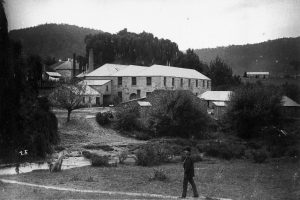The development of the Lithgow woollen mills is associated with the Andrew Brown‘s milling activities on his Cooerwull estate. In 1837 Brown built a flour mill to grind wheat that had been grown on his property and in the surrounding district.
With a growing emphasis on pastoral activities in the area, by 1857 Brown had replaced the machinery associated with the flour milling with machinery to mill wool. To further develop his milling operations, Brown encouraged a family of weavers from Scotland to move to Australia to assist him in the development of his wool mill. A wool wash was established and machinery to manufacture tweeds was developed. The machinery consisted of some small plant and a number of hand looms. The woollen mill was operational until 1875 when a new mill,with more up-to-date machinery was introduced to the site.
A waterwheel and steam engine supplied power to the mill until 1896 when they were replaced with a large boiler and engine. Further modifications were made to the mill in 1898.

The importance of the Tweed mill to the Lithgow economy was strengthened through the award of a contract to produce military khakis for the Australian Army. The operation of the mills continued for 115 years, ceasing production in 1972. Its contribution to local employment is well recognised through the history of the town’s development.
The City of Greater Lithgow acknowledges and appreciates the History excerpts taken from the Draft Economic Development Strategy for Lithgow which was researched and compiled by Economic and Community Development Class, University of Sydney October 1996



